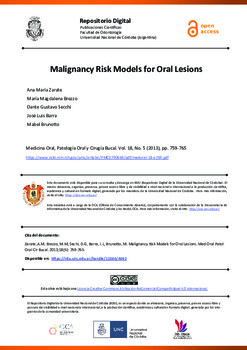| dc.contributor.author | Zárate, A.M. | |
| dc.contributor.author | Brezzo, M.M. | |
| dc.contributor.author | Secchi, D.G. | |
| dc.contributor.author | Barra, J.L. | |
| dc.contributor.author | Brunotto, M. | |
| dc.date.accessioned | 2017-08-07T13:33:35Z | |
| dc.date.available | 2017-08-07T13:33:35Z | |
| dc.date.issued | 2013 | |
| dc.identifier.citation | Zarate, A.M, Brezzo, M.M, Sechi, D.G, Barra, J.L, Brunotto, M. Malignancy Risk Models for Oral Lesions. Med Oral Patol Oral Cir Bucal. 2013;18(5): 759-765. | es |
| dc.identifier.issn | 1698-6946 | |
| dc.identifier.uri | http://hdl.handle.net/11086/4892 | |
| dc.description.abstract | Objectives: The aim of this work was to assess risk habits, clinical and cellular phenotypes and TP53 DNA changes in
oral mucosa samples from patients with Oral Potentially Malignant Disorders (OPMD), in order to create models that
enable genotypic and phenotypic patterns to be obtained that determine the risk of lesions becoming malignant.
Study Design: Clinical phenotypes, family history of cancer and risk habits were collected in clinical histories.
TP53 gene mutation and morphometric-morphological features were studied, and multivariate models were applied.
Three groups were estabished: a) oral cancer (OC) group (n=10), b) OPMD group (n=10), and c) control
group (n=8).
Results: An average of 50% of patients with malignancy were found to have smoking and drinking habits. A
high percentage of TP53 mutations were observed in OC (30%) and OPMD (average 20%) lesions (p=0.000). The
majority of these mutations were GC → TA transversion mutations (60%). However, patients with OC presented
mutations in all the exons and introns studied. Highest diagnostic accuracy (p=0.0001) was observed when incorporating
alcohol and tobacco habits variables with TP53 mutations.
Conclusions: Our results prove to be statistically reliable, with parameter estimates that are nearly unbiased even
for small sample sizes. Models 2 and 3 were the most accurate for assessing the risk of an OPMD becoming
cancerous. However, in a public health context, model 3 is the most recommended because the characteristics
considered are easier and less costly to evaluate. | es |
| dc.language.iso | eng | es |
| dc.publisher | Medicina Oral, Patología Oral y Cirugía Bucal. | es |
| dc.rights | Atribución-NoComercial-CompartirIgual 4.0 Internacional | * |
| dc.rights.uri | https://creativecommons.org/licenses/by-nc-sa/4.0/deed.es | * |
| dc.subject | Risk factors | es |
| dc.subject | Genotype | es |
| dc.subject | Phenotype | es |
| dc.subject | Neoplasms | es |
| dc.title | Malignancy risk models for oral lesions. | es |
| dc.type | article | es |
| dc.description.version | publishedVersion | es |





